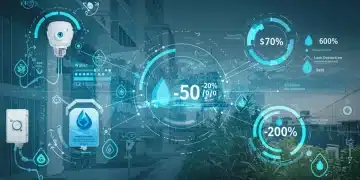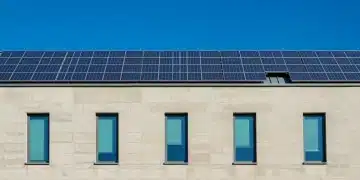Achieve 15% Energy Reduction: Eco-Friendly Home Upgrades in 6 Months
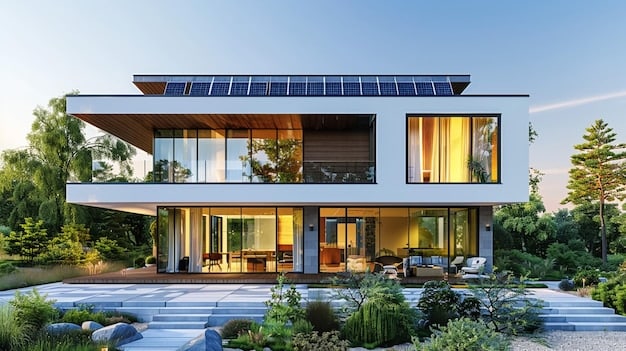
Achieving a 15% reduction in home energy consumption within six months is entirely feasible through strategic, eco-friendly upgrades, offering both financial savings and environmental benefits by focusing on immediate-impact improvements and sustainable practices.
Embarking on a journey to reduce your home’s energy consumption by 15% in the next 6 months with these simple eco-friendly upgrades is not merely an aspiration but an achievable goal for many homeowners across the US. This guide will walk you through practical, impactful steps designed to make your living space more energy-efficient, reduce your carbon footprint, and ultimately save you money on utility bills.
Understanding Your Home’s Energy Landscape
Understanding where your home consumes energy is the foundational step toward achieving a 15% reduction. Many homeowners are surprised to learn that heating and cooling often account for the largest portion of their energy bills, sometimes up to 50% or more. Identifying these primary energy drains allows for targeted interventions that deliver the most significant results. This initial assessment doesn’t require complex equipment; often, a review of past utility bills and a visual inspection of your home can offer valuable insights.
Analyzing Energy Bills and Usage Patterns
A deep dive into your monthly utility statements can reveal seasonal fluctuations and peak usage times. This data is crucial for understanding how your energy habits align with your home’s infrastructure. Look for trends that point to specific appliances or systems consuming more power than expected. Are there spikes in winter for heating or in summer for air conditioning? Pinpointing these patterns is key to crafting an effective reduction strategy.
- Review historical utility bills to identify consumption trends.
- Compare usage across seasons to understand heating and cooling impact.
- Note any unusual spikes that might indicate a malfunctioning appliance.
Beyond the bills, consider a quick walk-through of your home. Are there drafty windows or doors? Do old appliances hum constantly? These small observations can collectively paint a clear picture of your current energy landscape. Taking an inventory of light bulbs and their types, as well as insulation levels in your attic and walls, can also provide valuable insights into potential areas for improvement. Every detail contributes to a comprehensive understanding of your home’s energy profile.
Immediate Impact: Lighting and Smart Plugs
Two of the quickest and most cost-effective ways to begin reducing energy consumption involve upgrading your lighting and strategically employing smart plugs. These changes require minimal investment but yield noticeable results almost immediately. Shifting from traditional incandescent bulbs to LED lighting can instantly reduce electricity usage for illumination, while smart plugs offer convenient control over “vampire” energy drain from electronics.
Switching to LED Lighting
The transition to LED lighting is perhaps the simplest eco-friendly upgrade with a significant impact. LEDs consume up to 85% less energy than incandescent bulbs and last much longer, reducing both your electricity bill and the frequency of bulb replacement. Replacing just your most frequently used bulbs can lead to considerable savings over time. It’s an easy win that contributes directly to your 15% reduction goal.
- Identify high-usage areas for LED replacement first.
- Choose LED bulbs with appropriate brightness and color temperature.
- Dispose of old incandescent bulbs responsibly.
Smart use of natural light also plays a role here. Maximizing daylight hours by opening blinds and curtains can reduce the need for artificial lighting during the day. Consider installing dimmer switches with your new LED lights to further control energy usage and create ambient lighting as needed. Combining these practices ensures that your home is bright and energy-efficient without unnecessary consumption.
Leveraging Smart Plugs for Phantom Loads
Phantom loads, or “vampire energy,” refer to the electricity consumed by electronics when they are turned off but still plugged in. Devices like TVs, computers, and phone chargers continue to draw power even in standby mode. Smart plugs provide an elegant solution by allowing you to remotely turn off power to these devices, eliminating their standby consumption. This small change can add up to significant savings over the course of a year.
Smart plugs also offer the convenience of scheduling, so you can program devices to turn off automatically during hours when they are not in use. This level of control not only reduces energy waste but also simplifies energy management for a busy household. It’s a proactive step towards a more conscious energy footprint without sacrificing modern conveniences.
Optimizing Heating and Cooling Efficiency
Heating and cooling systems are typically the biggest energy consumers in any home. Therefore, optimizing their efficiency is paramount to achieving a 15% reduction in energy consumption. This involves more than just setting your thermostat; it encompasses improvements to insulation, air sealing, and the smart use of your HVAC system. Addressing these areas can yield some of the most substantial savings.
Enhanced Insulation and Air Sealing
Proper insulation acts as a barrier against heat transfer, keeping your home warmer in winter and cooler in summer. Upgrading attic insulation to recommended R-values can prevent significant heat loss or gain. Similarly, sealing air leaks around windows, doors, and utility penetrations prevents conditioned air from escaping and unconditioned air from entering. These improvements drastically reduce the workload on your HVAC system, translating directly into lower energy bills.
- Inspect and upgrade attic insulation to current standards.
- Seal cracks and gaps around doors, windows, and electrical outlets.
- Consider professional energy audit for hidden air leaks.
Air sealing can often be a DIY project, involving caulk for smaller gaps and weatherstripping for doors and windows. For larger areas or more complex scenarios, a professional energy audit can identify specific problem spots and recommend tailored solutions. Investing in these foundational improvements creates a more comfortable home environment while simultaneously boosting energy efficiency.
Smart Thermostats and HVAC Maintenance
A smart thermostat is an intelligent device that learns your schedule and temperature preferences, adjusting heating and cooling automatically to optimize energy use. Many models can be controlled remotely via a smartphone, allowing you to fine-tune your home’s climate even when you’re away. This level of precision prevents unnecessary energy expenditure, adapting to your lifestyle rather than adhering to rigid settings.
Regular maintenance of your heating, ventilation, and air conditioning (HVAC) system is equally crucial. A well-maintained unit runs more efficiently, consumes less energy, and has a longer lifespan. This includes routine filter changes, professional tune-ups, and ensuring that outdoor units are clear of debris. Neglecting maintenance can lead to decreased efficiency and higher energy bills, undermining your reduction efforts.
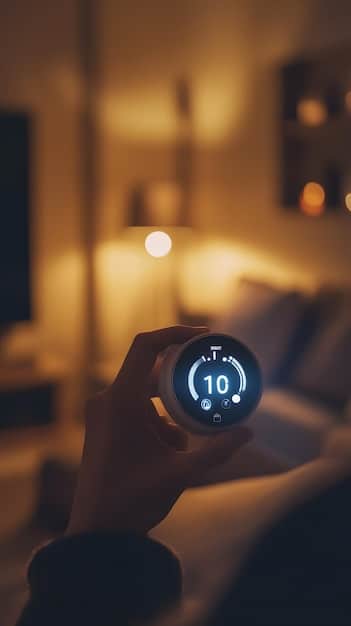
Water Heater Efficiency and Usage Habits
The water heater is another significant consumer of energy, responsible for a substantial portion of a household’s utility costs. Making eco-friendly upgrades and adjusting usage habits around hot water can contribute significantly to your 15% energy reduction goal. These changes range from minor adjustments to more substantial improvements, all aimed at minimizing the energy used to heat and deliver water.
Lowering Water Temperature and Insulation
One of the simplest ways to save energy is to lower your water heater’s thermostat setting to 120°F (49°C). This temperature is usually sufficient for most household needs and significantly reduces the energy required to maintain hot water. Additionally, insulating your water heater tank, especially if it’s an older model, can reduce standby heat loss. Insulated pipes can also help, ensuring hot water stays hot as it travels to your tap.
- Set water heater thermostat to 120°F (49°C).
- Insulate older water heater tanks with a specialized blanket.
- Insulate exposed hot water pipes to minimize heat loss.
These adjustments are often low-cost or even free, providing immediate energy savings. They prevent your water heater from working harder than necessary, making it a more efficient appliance. It’s a subtle change that contributes meaningfully to overall energy conservation without impacting comfort.
Efficient Showerheads and Laundry Practices
Upgrading to low-flow showerheads is a highly effective way to reduce both hot water consumption and the energy needed to heat it. These showerheads deliver a satisfying spray while using significantly less water per minute. Similarly, adopting energy-efficient laundry practices, such as washing clothes in cold water whenever possible, can lead to substantial energy savings. Most modern detergents are formulated to work effectively in cold water, making this an easy switch.
Consider also installing aerators on all faucets. These small devices mix air into the water stream, reducing the amount of water used without compromising water pressure. These collective small changes in water usage habits and fixtures can add up to a considerable reduction in energy expenditure.
Appliances and Electronics: Smart Choices
Investing in energy-efficient appliances and making conscious choices about how you use your electronics can play a pivotal role in achieving your energy reduction goals. Modern appliances are designed with energy conservation in mind, offering significant improvements over older models. Being mindful of your electronic usage habits further complements these upgrades, ensuring every watt counts.
Upgrading to ENERGY STAR Appliances
When it’s time to replace an old appliance, choosing an ENERGY STAR certified model is a smart investment. These appliances meet strict energy efficiency guidelines set by the U.S. Environmental Protection Agency. From refrigerators and dishwashers to washing machines and dryers, ENERGY STAR products use significantly less energy and water without sacrificing performance. While the initial cost might be slightly higher, the long-term savings on utility bills often outweigh the premium.
- Prioritize replacing older, high-use appliances with ENERGY STAR models.
- Look for ENERGY STAR labels when purchasing new electronics.
- Research state and local rebates for energy-efficient appliance purchases.
The impact of these upgrades is continuous, providing daily energy savings for years to come. Even smaller appliances, like microwaves and coffee makers, now come in energy-efficient versions. Making informed decisions at the point of purchase is a powerful way to embed energy savings into your home’s infrastructure.
Mindful Electronic Usage and Charging
Beyond smart plugs, cultivating mindful habits around your electronic usage can further reduce energy consumption. Fully charging devices like laptops and phones, then unplugging them, prevents prolonged trickle charging. Similarly, powering down computers and monitors when not in use, rather than leaving them in sleep mode, can contribute to savings. These seem like minor actions, but collectively, they make a difference.
Remember to unplug chargers when they are not connected to a device. Even tiny power bricks draw minimal energy when left plugged in, adding to that phantom load we discussed earlier. Integrating these small behavioral changes into your daily routine creates a more energy-conscious household without requiring significant effort or cost.
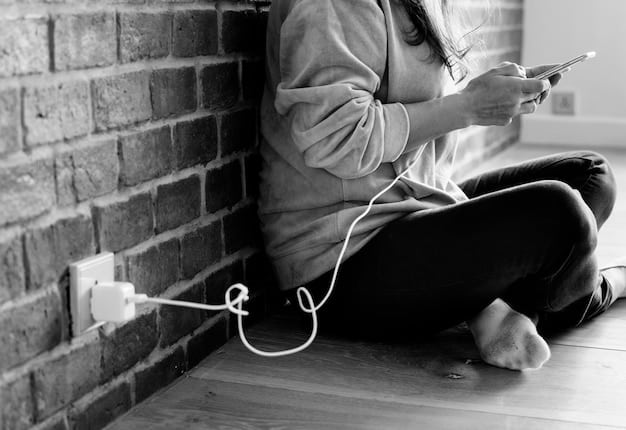
Renewable Energy and Advanced Monitoring
Once you’ve tackled the more immediate and cost-effective eco-friendly upgrades, exploring renewable energy options and advanced monitoring systems can further propel your home towards greater energy independence and efficiency. While these upgrades may involve a higher initial investment, they offer long-term financial and environmental benefits, cementing your commitment to sustainable living.
Exploring Solar Power Options
Solar panels represent a significant step towards self-sufficiency in energy production. Harnessing the sun’s energy can dramatically reduce or even eliminate your reliance on grid electricity, leading to substantial long-term savings. Solar technology has become more accessible and efficient, with various financing options and government incentives making it a viable consideration for many homeowners. Installing solar panels not only lowers your utility bills but also increases your home’s value and reduces your carbon footprint significantly.
The initial consultation with a solar provider can help determine the feasibility and potential savings for your specific home and location. Understanding local net metering policies and available tax credits is crucial for maximizing the financial benefits of solar energy. It’s an investment that pays dividends for decades.
Home Energy Monitoring Systems
Advanced home energy monitoring systems provide real-time data on your electricity consumption, offering unparalleled insight into where and how your energy is being used. These systems connect to your home’s electrical panel and transmit data to a smartphone app or web portal, allowing you to identify energy-hungry appliances or inefficient habits. This granular level of information empowers you to make smarter decisions about energy use throughout your home.
- Install a smart energy monitor for real-time consumption data.
- Use insights from monitoring to identify patterns and waste.
- Set energy-saving goals based on actual consumption data.
By seeing your energy consumption in real-time, you become more aware and proactive in managing your usage. Some systems can even identify specific appliances that are drawing power, providing targeted areas for improvement. This level of transparency is invaluable for maintaining energy efficiency and ensuring you stay on track with your 15% reduction goal and beyond.
Maintaining Your Eco-Friendly Momentum for Lasting Savings
Achieving a 15% reduction in home energy consumption is not a one-time effort but rather an ongoing commitment to sustainable living. Maintaining the momentum gained from initial eco-friendly upgrades requires continuous attention to energy-saving habits and periodic reassessments of your home’s efficiency. By doing so, you can ensure lasting savings on utility bills and a consistently reduced environmental footprint.
Regularly reviewing your utility bills, even after implementing upgrades, helps monitor the effectiveness of your efforts and identifies any new areas of concern. Just as importantly, staying informed about new energy-efficient technologies and eco-friendly practices can open doors to further savings down the line. The landscape of sustainable living is constantly evolving, with new innovations emerging that offer even greater efficiency.
Seasonal Adjustments and Behavioral Changes
Adapting your energy habits to the changing seasons is vital for sustained efficiency. This means adjusting thermostat settings according to outside temperatures, making sure windows are sealed before winter, and ensuring effective shading to block summer sun. Seasonal maintenance of your HVAC system, such as cleaning coils and replacing filters, also contributes significantly to maintaining optimal performance and energy use.
Reinforcing energy-saving behaviors among all household members is also key. Simple actions, like turning off lights when leaving a room, unplugging chargers, and taking shorter showers, should become second nature. These collective small efforts, when consistently practiced, reinforce the impact of your eco-friendly upgrades and help keep your energy consumption low year-round.
Exploring Government Incentives and Community Programs
Many governments and local utility companies offer incentives, rebates, and programs to encourage homeowners to adopt energy-efficient upgrades. Researching these opportunities can help offset the cost of further improvements, making advanced eco-friendly solutions more accessible. These incentives are designed to promote sustainable practices and can provide valuable financial support for your ongoing energy reduction efforts.
Community programs often offer energy audits or workshops that can provide personalized advice and support. Engaging with these resources not only helps you save more but also connects you with a broader network of like-minded individuals committed to environmental responsibility. Staying proactive and connected ensures your home remains a beacon of energy efficiency for years to come.
| Key Upgrade | Brief Description |
|---|---|
| 💡 LED Lighting | Replaces incandescent bulbs, saving up to 85% energy. |
| 🔌 Smart Plugs | Eliminates “vampire” energy drain from electronics. |
| 🏡 Insulation/Air Sealing | Prevents heat loss/gain, reducing HVAC workload. |
| 💧 Water Heater Optimization | Lowers temperature, insulates tank, and uses efficient fixtures. |
Frequently Asked Questions About Energy Reduction
You can often see initial savings within the first month after implementing simple upgrades like switching to LED lighting and using smart plugs. These changes immediately impact your electricity consumption, with noticeable differences appearing on your next utility bill, demonstrating the direct benefits of your actions.
Yes, many federal, state, and local governments, as well as utility companies, offer incentives, rebates, and tax credits for homeowners who invest in energy-efficient upgrades. It’s highly recommended to research programs available in your specific area to maximize your savings and recoup upgrade costs.
“Phantom load,” also known as “vampire energy,” is the electricity consumed by electronics when they are turned off but still plugged in. While individual devices may only draw small amounts, collectively, phantom loads can account for 5-10% of your total home energy consumption, making smart plugs a valuable solution.
While solar panels can certainly contribute significantly to reducing energy consumption, they typically involve a higher initial investment than other upgrades. They are highly effective for long-term, substantial energy independence, often yielding far more than a 15% reduction over time, especially with favorable local incentives.
It’s generally recommended to conduct a professional home energy audit every 5-10 years, or if you notice unexplained spikes in your energy bills or significant changes in your home’s comfort levels. Routine self-assessments, like checking for drafts, can be done more frequently to catch minor issues early.
Conclusion
Achieving a 15% energy reduction in your home within the next six months is not just an ideal—it’s a realistic and highly actionable goal. As demonstrated in cases like the decarbonization journey of a historic property highlighted pela Schneider Electric, onde melhorias simples resultaram em uma redução significativa de consumo em apenas meio ano — veja essa referência inspiradora sobre energy reduction in practice — pequenos passos consistentes geram grandes resultados.
By strategically implementing accessible eco-friendly upgrades, from LED lighting and smart plugs to better insulation and energy-aware appliance choices, homeowners can unlock measurable savings while actively contributing to environmental responsibility. Beyond reducing bills, this process enhances comfort, increases long-term property value and grants you full control over your energy footprint—turning everyday choices into a meaningful step toward a more sustainable future.


